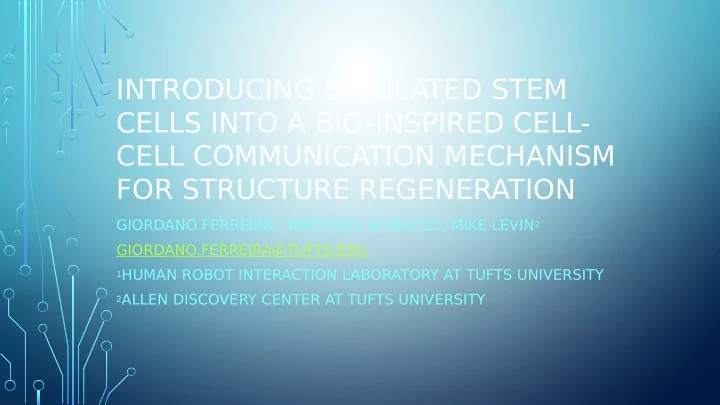

INTRODUCING SIMULATED STEM CELLS INTO A BIO-INSPIRED CELL- CELL COMMUNICATION MECHANISM FOR STRUCTURE REGENERATION GIORDANO FERREIRA 1 , MATTHIAS SCHEUTZ 1 , MIKE LEVIN 2 GIORDANO.FERREIRA@TUFTS.EDU 1 HUMAN ROBOT INTERACTION LABORATORY AT TUFTS UNIVERSITY 2 ALLEN DISCOVERY CENTER AT TUFTS UNIVERSITY
INTRODUCTION 2
INTRODUCTION • Note that the shape to which an animal regenerates upon damage can be altered without genetic changes • For example, it is possible to produce two headed planarian worms • Genes and proteins involved in regeneration are known, but the exact mechanism of storing and using morphological information for 3 regeneration is still unknown
COMPUTATIONAL MODEL OF MORPHOLOGY DISCOVERY AND REPAIR • We previously developed a model that could discover the morphological information of an organism, during a discovery phase • Later, when the organism was lesioned the dynamic messaging mechanism in the model was able to cause regeneration of the damaged parts • While the model has not been linked to biological mechanisms yet, it has demonstrated a variety of functional 4 properties of regeneration displayed by planaria
FEATURES OF THE MODEL • Proposed in Ferreira et al. 2016 3 • Morphological information is stored in a dynamic distributed fashion across cells • The genome is hypothesized to encode the computational machinery necessary for carrying out morphological discovery and repair • A key feature of the model is that it can dynamically learn and maintain new morphologies using the same computational mechanism 3 Ferreira, G. B. S., Smiley, M., Scheutz, M., and Levin, M. (2016). Dynamic structure discovery and repair 5 for 3d cell assemblages. In Proceedings of the Fifteenth International Conference on the Synthesis and Simulation of Living Systems (ALIFEXV)
DISCOVERY Cells send messages to other cells containing information about the 6 path that those messages traveled.
REGENERATION Then those message packets ”backtrack” verifying 7 if there exists a missing cell in the previous path, repairing it.
REGENERATION 8
REGENERATION 9
PREVIOUS FINDINGS • In Ferreira et al (2016) 3 we showed that this model was capable of maintaining the structure of the worm indefjnitely in the light of random damages happening to parts of it • However, communication was assumed to be perfect and without losses, which is not realistic in any actual organism • In Ferreira et al (2017) 4 we investigated our model of dynamic messaging morphology discovery and repair under various conditions of noise and proposed simple extensions to overcome the detrimental efgects of noise 3 Ferreira, G. B. S., Smiley, M., Scheutz, M., and Levin, M. (2016). Dynamic structure discovery and 10 repair for 3d cell assemblages. In Proceedings of the Fifteenth International Conference on the Synthesis and Simulation of Living Systems (ALIFEXV) 4 Ferreira, G. B. S., Smiley, M., Scheutz, M., and Levin, M. (2017). Investigating the Efgects of Noise on a Cell-to-Cell Communication Mechanism for Structure Regeneration. In Proceedings of the 14th
ADULT STEM CELLS – ”NEOBLASTS” • An explanation for Planaria’s regeneration capabilities is the high number of adult stem cells (called ”neoblasts”) that exist in their body • Between 20% and 30% of cells in Planaria are neoblasts • Neoblasts are the only type of cells capable of dividing and difgerentiating into any other cell type • Worms with no neoblasts lose their regeneration capabilities 11
SIMULATED NEOBLASTS • In this work, we proposed two types of cells: neoblasts and difgerentiated cells • Neoblasts are capable of sending new packets • Difgerentiated cells only relay messages they receive • We want to verify the necessary proportion of neoblasts to completely regenerate the organism from a large tissue removal 12
DISCOVERY WITH NEOBLASTS 13
REGENERATION WITH NEOBLASTS 14
SIMPLIFICATIONS IN THE MODEL • In our model, all cells can divide, which is not what real worms show • In real worms, neoblasts migrate to the area of the injury and create a mass of cells called blastema. A key question yet to be answered is how neoblasts know there is an injury which allows them to migrate 15
SIMULATED MORPHOLOGY 16
WORM CUT 17
RESULTS – FULL REGENERATION • The model completely regenerated the simulated worm in 23% (6210 out of 27000) of the parameter space 18
RESULTS – FULL REGENERATION 19
RESULTS – REGENERATION RATIO • 20
RESULTS – REGENERATION RATIO ”Average worm” RegenerationRatio = RegenerationRatio = 21 RegenerationRatio=89.5% 20% 50%
CONCLUSION • We changed our model of dynamic messaging morphology regeneration to show two types of cells: neoblasts and difgerentiated cells and we investigated the model under various ratios of neoblasts • Large parameter sweeps of the model determined that even for small ratios of neoblasts (10% for instance) the model was able to fully regenerate the original morphology • As next steps, we want to investigate the model with neoblasts and noise on communication. We also want to add cell migration capabilities to the model and allow only neoblasts to divide 22
Recommend
More recommend